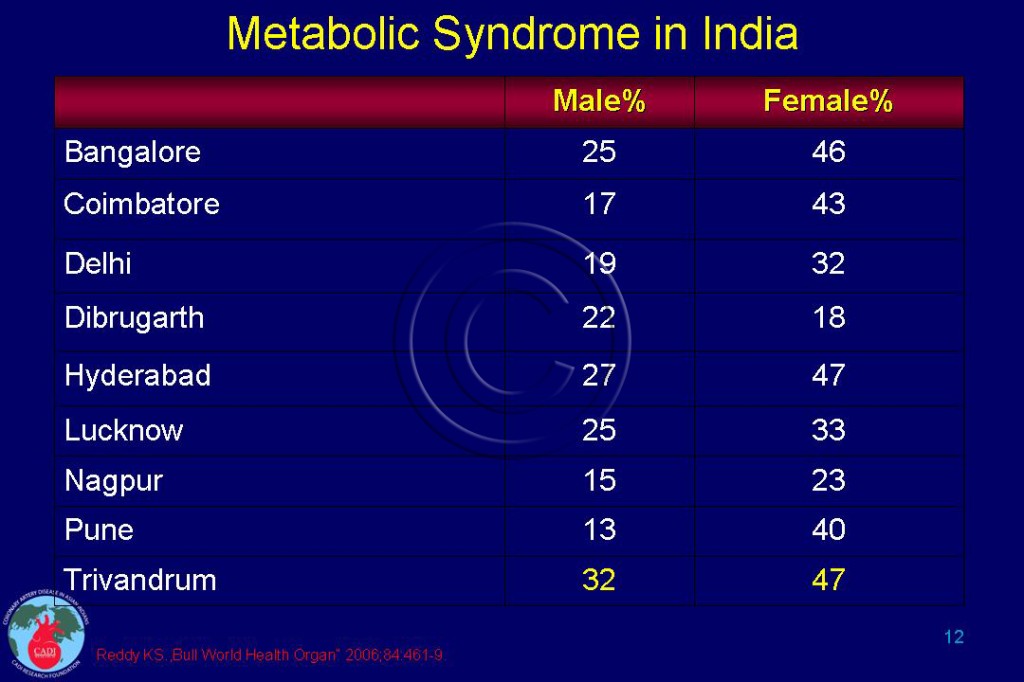Metabolic Syndrome in India
- Metabolic syndrome (MS) is a crucial factor in causation of diabetes and coronary artery disease (CAD) in Asian Indians. The prevalence of MS varies by the criteria used and the population studied, with greater prevalence in urban areas and in people with diabetes or obesity. In addition, there is a wide regional variation in the prevalence of MS from as low as 13% to as high as 47%.1 (Table 012)
- In India, the prevalence of MS is higher in urban areas, compared with rural areas and rises further with higher socioeconomic status.2-4
- Gupta and colleagues5 have reported a prevalence of MS of 25% among urban Asian Indians (18% men and 31% women) using NCEP criteria.
- In the Chennai Urban Rural Epidemiology Study (CURES) the prevalence of MS was 26% with IDF criteria, 18% with NCEP criteria, and 23% with WHO criteria.6 However, the concordance among the 3 sets of criteria was very poor; only 30% of the Indian population was identified to have MS by all three sets of criteria, unlike more than 93% of the US population.6
- The South Asian modified specific NCEP criteria appears to be more accurate in determining the prevalence of MS in Indians.7, 8 One study from rural Andhra Pradesh, India, involving 4,535 adults aged 30 years and older showed a prevalence of MS of 27% in men and 18% in women, which increased to 33% and 24%, respectively, when SAM-NCEP criteria were applied.9 In a large, contemporary, multicenter study involving 19,973 subjects in India, the prevalence of MS was 27% with NCEP criteria but increased to 35% with SAM-NCEP criteria.1
- Significant differences exist in the prevalence of various components of the MS even within an urban environment and this appears to be influenced by socioeconomic status.4
- Furthermore, insulin resistance (a precursor to MS) was reported to be present in nearly 30% of children and adolescents in India, more so in girls.10
- Approximately 30-50% of urban South Asians have MS.5, 7 The prevalence increases to >73% in people with diabetes with women having even higher prevalence (83%) compared to men (65%).11
- The prevalence of MS was 41% (men 36% and women 47%) in urban Chennai using waist circumference >90cm in men and >85cm in women as criteria for abdominal obesity.12
- The prevalence of MS is particularly high in people with prediabetes and diabetes. In one study, the prevalence of MS increased from 28% in people with normal fasting blood sugar to >70% in people with prediabetes and diabetes.12
Sources
1. Reddy KS, Prabhakaran D, Chaturvedi V, et al. Methods for establishing a surveillance system for cardiovascular diseases in Indian industrial populations. Bull World Health Organ. Jun 2006;84(6):461-469.
2. Mohan V, Gokulakrishnan K, Deepa R, Shanthirani CS, Datta M. Association of physical inactivity with components of metabolic syndrome and coronary artery disease–the Chennai Urban Population Study (CUPS no. 15). Diabet Med. Sep 2005;22(9):1206-1211.
3. Ramachandran A, Snehalatha C, Latha E, Satyavani K, Vijay V. Clustering of cardiovascular risk factors in urban Asian Indians. Diabetes Care. 1998;21(6):967-971.
4. Mohan V, Shanthirani S, Deepa R, Premalatha G, Sastry NG, Saroja R. Intra-urban differences in the prevalence of the metabolic syndrome in southern India — the Chennai Urban Population Study (CUPS No. 4). Diabet Med. 2001;18(4):280-287.
5. Gupta R, Deedwania PC, Gupta A, Rastogi S, Panwar RB, Kothari K. Prevalence of metabolic syndrome in an Indian urban population. Int J Cardiol. Nov 2004;97(2):257-261.
6. Deepa M, Farooq S, Datta M, Deepa R, Mohan V. Prevalence of metabolic syndrome using WHO, ATPIII and IDF definitions in Asian Indians: the Chennai Urban Rural Epidemiology Study (CURES-34). Diabetes/metabolism research and reviews. Feb 2007;23(2):127-134.
7. Enas EA, Mohan V, Deepa M, Farooq S, Pazhoor S, Chennikkara H. The metabolic syndrome and dyslipidemia among Asian Indians: a population with high rates of diabetes and premature coronary artery disease. Journal of the cardiometabolic syndrome. Fall 2007;2(4):267-275.
8. Mohan V, Deepa M, Farooq, Narayanan K, Datta M, Deepa R. Anthrpometric cutponts for identification of cardiometabolic risk factors in an urban asian indian population. metabolism. 2007:(in Press).
9. Chow CK, Naidu S, Raju K, et al. Significant lipid, adiposity and metabolic abnormalities amongst 4535 Indians from a developing region of rural Andhra Pradesh. Atherosclerosis. Apr 26 2007.
10. Misra A, Misra R, Wijesuriya M, Banerjee D. The metabolic syndrome in South Asians: continuing escalation & possible solutions. Indian J Med Res. Mar 2007;125(3):345-354.
11. Raman R, Gupta A, Pal SS, et al. Prevalence of Metabolic Syndrome and its influence on microvascular complications in the Indian population with Type 2 Diabetes Mellitus. Sankara Nethralaya Diabetic Retinopathy Epidemiology And Molecular Genetic Study (SN-DREAMS, report 14). Diabetol Metab Syndr. 2010;2:67.
12. Ramachandran A, Snehalatha C, Satyavani K, Sivasankari S, Vijay V. Metabolic syndrome in urban Asian Indian adults–a population study using modified ATP III criteria. Diabetes Res Clin Pract. Jun 2003;60(3):199-204.


